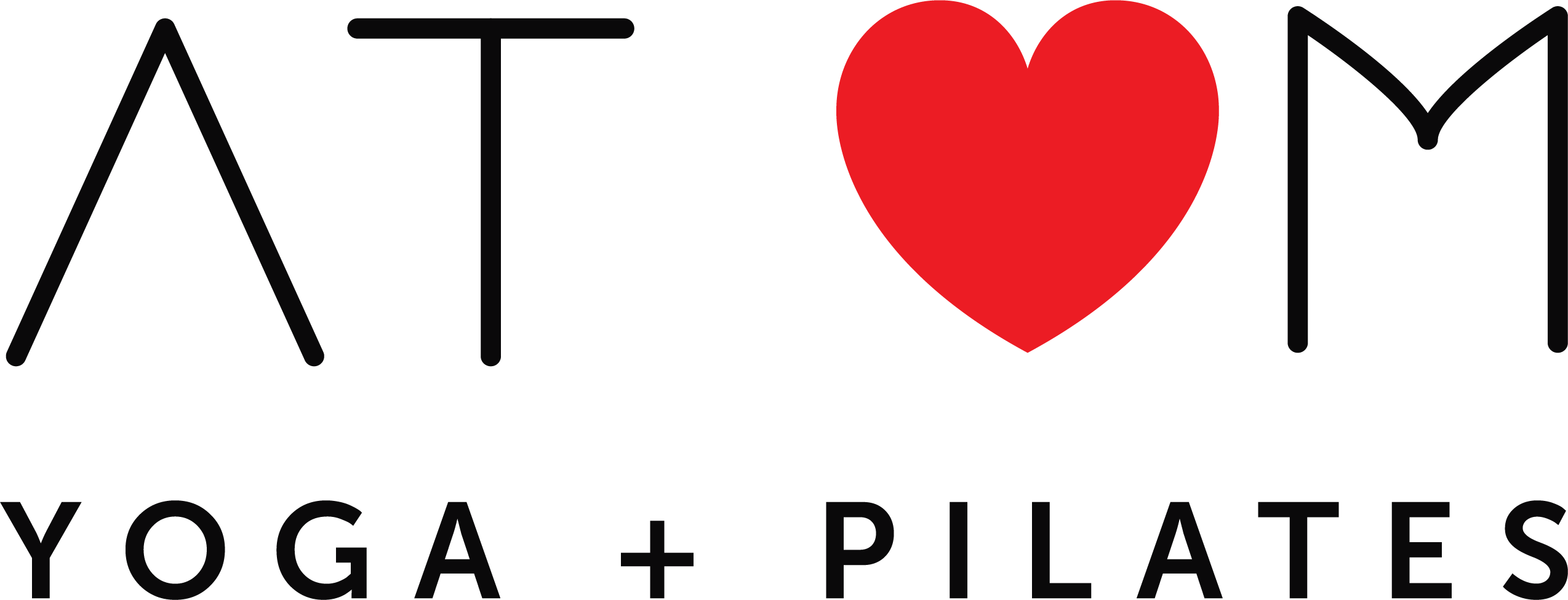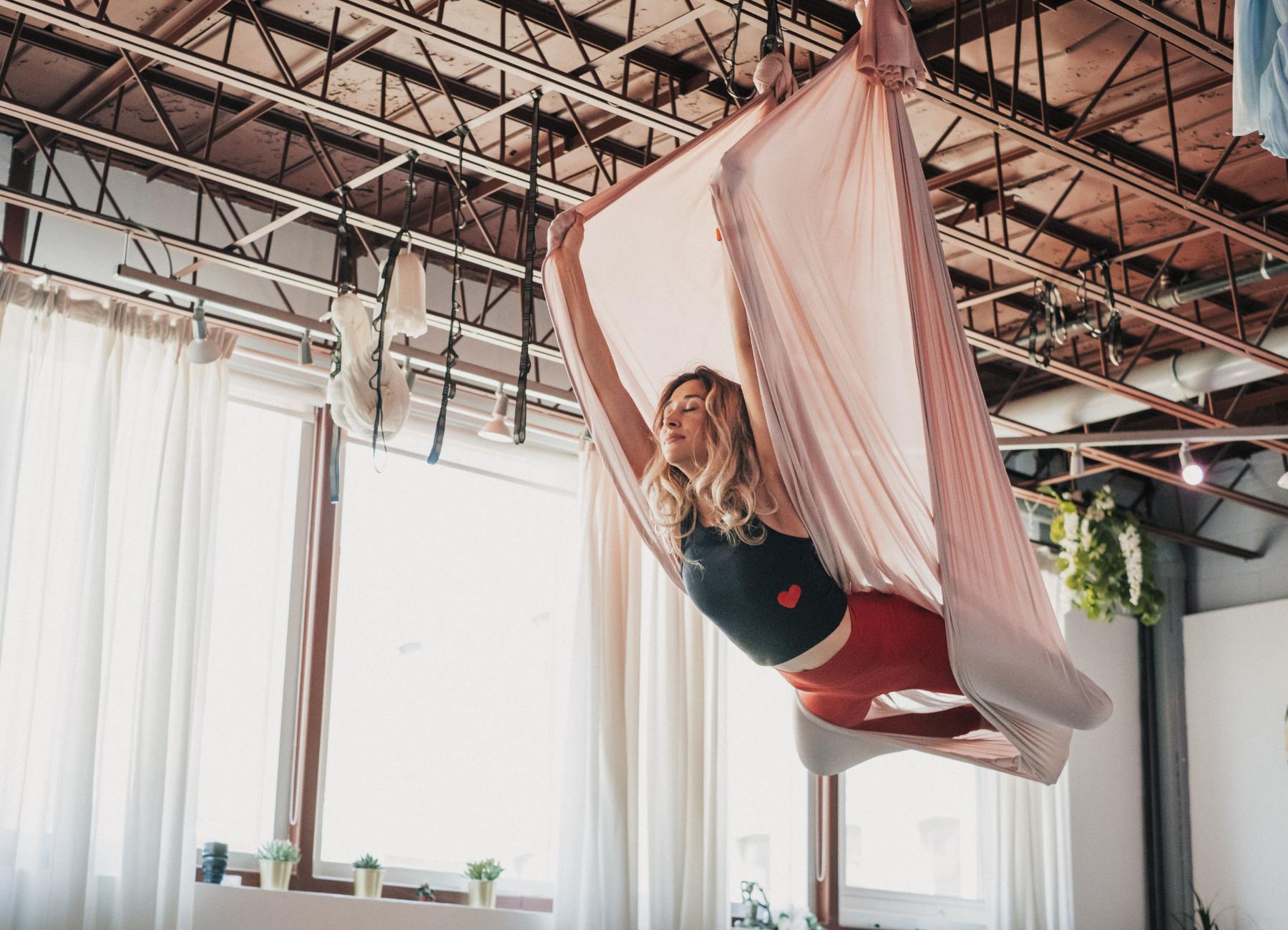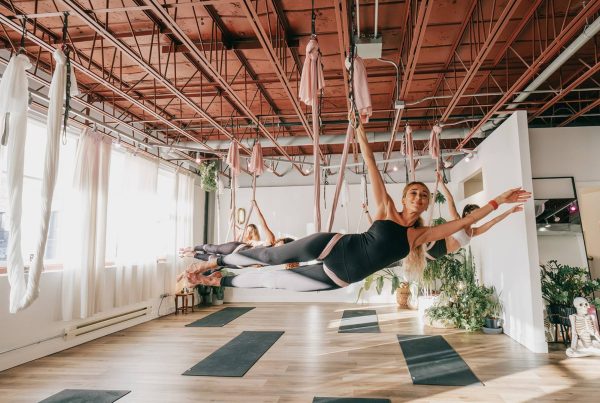Breath is often treated as background noise, something we do automatically without thought. But in yoga, and especially in aerial yoga, breath becomes a partner to movement. The hammock supports the body in ways the mat cannot, allowing more space in the ribs, diaphragm, and lungs. With the right holds, students discover how breath can expand deeper, slow down naturally, and bring calm clarity into each practice.
Aerial Yoga Inverted Butterfly Hold Deepening Diaphragmatic Expansion
In the inverted butterfly hold, the body hangs upside down with legs bent outward, supported securely by the hammock. This position flips gravity’s effect on the diaphragm, allowing it to move with more freedom. As the lungs expand downward toward the chest cavity, the diaphragm stretches and strengthens, encouraging a fuller range of motion. Practicing this hold consistently can reduce shallow breathing patterns that come from tension or poor posture.
Beyond the diaphragm, the inversion encourages blood flow to the head and upper body, enriching oxygen exchange. By training the body to draw in longer and more controlled inhales, the inverted butterfly becomes a practice in breathing stamina.
Supported Star Pose in Aerial Yoga Enhancing Steady Breath Rhythm
The supported star pose spreads the body wide with arms and legs extended, held securely by the hammock under the torso. This position creates openness across the chest and ribcage, making it easier to regulate breath rhythm. With the lungs uncompressed, each breath feels expansive and steady, and students can explore longer, more consistent cycles of inhalation and exhalation.
Another benefit of the star pose is its grounding effect, even while suspended. By evenly distributing body weight, the pose relaxes tension in the shoulders and back—two areas that often restrict healthy breathing. Over time, practicing this posture encourages the habit of breathing evenly, a rhythm that enhances focus during aerial yoga sessions and daily activities.
Hammock-assisted Fish Pose Opening the Chest for Fuller Inhalations
Fish pose already focuses on chest opening, but the hammock intensifies it by lifting the spine into a supported arch. This added lift takes pressure off the back muscles and lets the ribcage expand more freely. The result is deeper inhalations with less physical strain.
In this position, each breath feels fuller because the chest opens in multiple directions. Instead of forcing the stretch, the hammock gently cradles the spine, letting air flow more naturally. The expansion supports lung health and can be especially helpful for anyone who spends long hours seated at a desk. This shows how yoga can become both restorative and strengthening.
Aerial Yoga Seated Straddle Hold Strengthening Controlled Exhalations
The seated straddle hold, where the hammock supports the hips while the legs extend outward, emphasizes balance and control. With the core engaged, students learn to regulate their exhalations, training abdominal muscles to assist in releasing air steadily. This strengthens respiratory endurance and encourages mindful, slower breathing patterns.
The position also supports posture by keeping the spine tall and the chest lifted. This upright alignment ensures that the diaphragm and lungs are unrestricted, making it easier to practice controlled breathing. The straddle hold’s dual focus on balance and exhalation control makes it one of the most effective aerial yoga poses for developing precision in breathwork.
Floating Lotus Pose Improving Calm and Measured Breath Cycles
Floating lotus combines cross-legged seating with the hammock holding the body slightly above the ground. This suspended meditation posture steadies both mind and body. The gentle rocking that often happens in the hammock supports slower, more measured breathing cycles.
Breath becomes calm and rhythmic in this position. The nervous system settles, and the inhale and exhale naturally lengthen. Practicing in floating lotus encourages mindfulness, making it easier to translate calm breath into meditation or stressful daily situations. It shows how yoga postures can improve both focus and relaxation.
Aerial Yoga Supported Backbend Hold Creating Space for Lung Capacity
The supported backbend uses the hammock to lift the body into an arch, with arms and chest open wide. This creates more space for the lungs to expand fully with each inhale. Unlike floor-based backbends, the hammock reduces compression in the lower back, making the posture more accessible.
With practice, students experience noticeable increases in lung capacity. Each inhale feels less restricted, and exhalations become smoother. This is a powerful posture for training breath depth, showing how aerial yoga creates possibilities that standard mat work cannot.
Cocoon Pose in Aerial Yoga Encouraging Slow and Mindful Breathing
Cocoon pose wraps the body fully in the hammock, much like a floating savasana. The sense of weightlessness quiets the mind and encourages breathing to slow naturally. This calm environment helps the body reset its rhythm without force.
Breath awareness deepens as the hammock blocks external distractions. Practitioners often notice their inhales and exhales become longer and more mindful. Cocoon pose demonstrates how aerial yoga integrates rest into breath training, proving that stillness can be as powerful as movement.
Side-lying Aerial Stretch Balancing Breath Between Both Lungs
The side-lying stretch uses the hammock to support the body on one side while the chest opens diagonally. This unusual orientation creates awareness of how each lung expands differently. Practicing on both sides balances breath and strengthens control.
This posture helps students tune into subtle differences in expansion and contraction between left and right lungs. Over time, breath feels more balanced, improving overall control and awareness. It’s a unique benefit of aerial yoga, highlighting how gravity and support can uncover new ways to train breathing.
Discover Transformative Breathing Practices Through Aerial Yoga with AT OM Yoga
Developing stronger breath control isn’t only about building lung strength—it’s about creating space, rhythm, and balance in the body. AT OM Yoga offers expert instruction in aerial yoga, guiding students through holds that unlock deeper inhalations, steadier exhalations, and calmer cycles of breath. Our classes bring together mindful technique and supportive teaching that help students reach new levels of awareness.
Each hold, from cocoon pose to inverted butterfly, becomes a lesson in how breath shapes energy and focus. At AT OM Yoga, the practice goes beyond movement by teaching students how to breathe with intention. This approach creates long-lasting improvements that extend far beyond the hammock and into daily life.
If you’re ready to transform your practice and discover how breath can truly change the way you feel, AT OM Yoga is the place to begin. Contact us today and experience how aerial yoga can reshape not just your posture, but your entire relationship with breathing.








